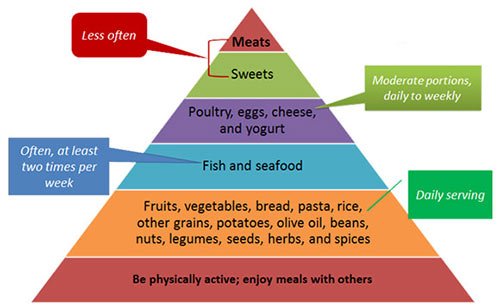The Mediterranean diet is based on the traditional foods that people used to eat in countries like Italy and Greece back in the year 1960.
Researchers noted that these people were exceptionally healthy compared to Americans and had a low risk of many killer diseases.
Numerous studies have now shown that the Mediterranean diet can cause weight loss and help prevent heart attacks, strokes, type 2 diabetes and premature death.

A Mediterranean Diet Meal Plan
There is no one “right” way to do this diet. There are many countries around the Mediterranean sea and they didn’t all eat the same things.
This article describes the diet that was typically prescribed in the studies that showed it to be an effective way of eating.
Consider all of this as a general guideline, not something written in stone. The plan can be adjusted to individual needs and preferences.
The Basics
Eat: Vegetables, fruits, nuts, seeds, legumes, potatoes, whole grains, breads, herbs, spices, fish, seafood and extra virgin olive oil.
Eat in Moderation: Poultry, eggs, cheese and yogurt.
Eat Only Rarely: Red meat.
Don’t Eat: Sugar-sweetened beverages, added sugars, processed meat, refined grains, refined oils and other highly processed foods.
Avoid These Unhealthy Foods
You should avoid these unhealthy foods and ingredients:
Added sugar: Soda, candies, ice cream, table sugar and many others.
Refined grains: White bread, pasta made with refined wheat, etc.
Trans fats: Found in margarine and various processed foods.
Refined Oils: Soybean oil, canola oil, cottonseed oil and others.
Processed meat: Processed sausages, hot dogs, etc.
Highly processed foods: Everything labelled “low-fat” or “diet” or looks like it was made in a factory.
You MUST read ingredients lists if you want to avoid these unhealthy ingredients.
Foods to Eat
You should base your diet on these healthy, unprocessed Mediterranean foods.
1. Vegetables: Tomatoes, broccoli, kale, spinach, onions, cauliflower, carrots, Brussels sprouts, cucumbers, etc.
2. Fruits: Apples, bananas, oranges, pears, strawberries, grapes, dates, figs, melons, peaches, etc.
3. Nuts and Seeds: Almonds, walnuts, Macadamia nuts, hazelnuts, cashews, sunflower seeds, pumpkin seeds and more.
4. Legumes: Beans, peas, lentils, pulses, peanuts, chickpeas, etc.
5. Tubers: Potatoes, sweet potatoes, turnips, yams, etc.
6. Whole Grains: Whole oats, brown rice, rye, barley, corn, buckwheat, whole wheat, whole grain bread and pasta.
7. Fish and Seafood: Salmon, sardines, trout, tuna, mackerel, shrimp, oysters, clams, crab, mussels, etc.
8. Poultry: Chicken, duck, turkey and more.
9. Eggs: Chicken, quail and duck eggs.
10. Dairy: Cheese, yogurt, Greek yogurt, etc.
11. Herbs and Spices: Garlic, basil, mint, rosemary, sage, nutmeg, cinnamon, pepper, etc.
12. Healthy Fats: Extra virgin olive oil, olives, avocados and avocado oil.
Whole, single ingredient foods are the key to good health.
A Few Things Worth Noting
Exactly which foods belong in the Mediterranean diet is controversial, partly because there is such variety between different countries.
The diet prescribed in the studies is high in plant foods, and relatively low in animal foods.
However, eating fish and seafood is recommended at least twice a week.
The Mediterranean lifestyle also involves regular physical activity, sharing meals with other people and enjoying life.
What to Drink
Water should be your go-to beverage on a Mediterranean diet.
This diet also includes moderate amounts of red wine, around 1 glass per day.
However, this is completely optional and wine should be avoided by anyone who has alcoholism or problems controlling their consumption.
Coffee and tea are also completely acceptable, but avoid sugar-sweetened beverages and fruit juices, which are very high in sugar.
A Mediterranean Sample Menu For 1 Week
This is a sample menu for one week on the Mediterranean diet.
Feel free to adjust the portions and food choices based on your own needs and preferences.
Monday
Breakfast: Greek yogurt with strawberries and oats.
Lunch: Whole grain sandwich with vegetables.
Dinner: A tuna salad, dressed in olive oil. A piece of fruit for dessert.
Tuesday
Breakfast: Oatmeal with raisins.
Lunch: Leftover tuna salad from the night before.
Dinner: Salad with tomatoes, olives and feta cheese.
Wednesday
Breakfast: Omelet with veggies, tomatoes and onions. A piece of fruit.
Lunch: Whole grain sandwich, with cheese and fresh vegetables.
Dinner: Mediterranean lasagne.
Thursday
Breakfast: Yogurt with sliced fruits and nuts.
Lunch: Leftover lasagne from the night before.
Dinner: Broiled salmon, served with brown rice and vegetables.
Friday
Breakfast: Eggs and vegetables, fried in olive oil.
Lunch: Greek yogurt with strawberries, oats and nuts.
Dinner: Grilled lamb, with salad and baked potato.
Saturday
Breakfast: Oatmeal with raisins, nuts and an apple.
Lunch: Whole grain sandwich with vegetables.
Dinner: Mediterranean pizza made with whole wheat, topped with cheese, vegetables and olives.
Sunday
Breakfast: Omelet with veggies and olives.
Lunch: Leftover pizza from the night before.
Dinner: Grilled chicken, with vegetables and a potato. Fruit for dessert.
There is usually no need to count calories or track macronutrients (protein, fat and carbs) on the Mediterranean diet.
Source: authoritynutrition.com